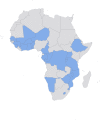Individual, maternal and household risk factors for anaemia among young children in sub-Saharan Africa: a cross-sectional study
- PMID: 29764873
- PMCID: PMC5961577
- DOI: 10.1136/bmjopen-2017-019654
Individual, maternal and household risk factors for anaemia among young children in sub-Saharan Africa: a cross-sectional study
Abstract
Objective: Anaemia affects the majority of children in sub-Saharan Africa (SSA). Previous studies of risk factors for anaemia have been limited by sample size, geography and the association of many risk factors with poverty. In order to measure the relative impact of individual, maternal and household risk factors for anaemia in young children, we analysed data from all SSA countries that performed haemoglobin (Hb) testing in the Demographic and Health Surveys.
Design and setting: This cross-sectional study pooled household-level data from the most recent Demographic and Health Surveys conducted in 27 SSA between 2008 and 2014.
Participants: 96 804 children age 6-59 months.
Results: The prevalence of childhood anaemia (defined as Hb <11 g/dL) across the region was 59.9%, ranging from 23.7% in Rwanda to 87.9% in Burkina Faso. In multivariable regression models, older age, female sex, greater wealth, fewer household members, greater height-for-age, older maternal age, higher maternal body mass index, current maternal pregnancy and higher maternal Hb, and absence of recent fever were associated with higher Hb in tested children. Demographic, socioeconomic factors, family structure, water/sanitation, growth, maternal health and recent illnesses were significantly associated with the presence of childhood anaemia. These risk factor groups explain a significant fraction of anaemia (ranging from 1.0% to 16.7%) at the population level.
Conclusions: The findings from our analysis of risk factors for anaemia in SSA underscore the importance of family and socioeconomic context in childhood anaemia. These data highlight the need for integrated programmes that address the multifactorial nature of childhood anaemia.
Keywords: anaemia; demographic and health surveys; global health; sub-saharan Africa.
© Article author(s) (or their employer(s) unless otherwise stated in the text of the article) 2018. All rights reserved. No commercial use is permitted unless otherwise expressly granted.
Conflict of interest statement
Competing interests: None declared.
Figures
References
-
- Stevens GA, Finucane MM, De-Regil LM, et al. . Global, regional, and national trends in haemoglobin concentration and prevalence of total and severe anaemia in children and pregnant and non-pregnant women for 1995-2011: a systematic analysis of population-representative data. Lancet Glob Health 2013;1:e16–e25. 10.1016/S2214-109X(13)70001-9 - DOI - PMC - PubMed
Publication types
MeSH terms
Grants and funding
LinkOut - more resources
Full Text Sources
Other Literature Sources
Medical
Research Materials


